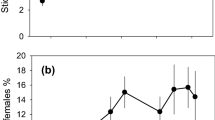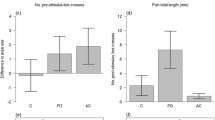Abstract
Algae blooms, which can be caused by eutrophication, drastically influence the ecology and behaviour of aquatic organisms. Such impact is often demonstrated in the context of mate choice and predator–prey interactions. In contrast, the influence of increased turbidity on social behaviour is less well understood, although it may have strong influence, at both the level of the individual and the population. We aimed to address this gap in our knowledge by using the well-described preference of three-spined sticklebacks (Gasterosteus aculeatus) to shoal with the larger of two shoals as model behaviour. In our experiments focal fish had the choice between two shoals of different sizes, either in clear or in turbid water containing green algae. Fish in clear water spent significantly more time near the larger shoal, while fish in algae water showed no significant preferences. Furthermore, fish tested in clear water changed more often between the shoals than fish tested in algae water. These results indicate that eutrophication-induced algae blooms have the potential to alter social decisions of sticklebacks. Such changes of social decisions do not only influence the behaviour of individuals, furthermore it might influence entire populations. This might eventually lead to changes of the structure of the social system.

Similar content being viewed by others
References
Barber I (2003) Parasites and size-assortative schooling in three-spined sticklebacks. Oikos 101:331–337
Barber I, Huntingford FA, Crompton DWT (1995) The effect of hunger and cestode parasitism on the shoaling decisions of small fresh-water fish. J Fish Biol 47:524–536
Barber I, Wright HA (2001) How strong are familiarity preferences in shoaling fish? Anim Behav 61:975–979
Botham MS, Kerfoot CJ, Louca V, Krause J (2005) Predator choice in the field: grouping guppies, Poecilia reticulata, receive more attacks. Behav Ecol Sociobiol 59:181–184
Boughman JW (2001) Divergent sexual selection enhances reproductive isolation in sticklebacks. Nature 411:944–948
Candolin U (2009) Population responses to anthropogenic disturbance: lessons from three-spined sticklebacks Gasterosteus aculeatus in eutrophic habitats. J Fish Biol 75:2108–2121
Carlson RE (1977) A trophic state index for lakes. Limnol Oceanogr 22:361–369
Darimont CT, Carlson SM, Kinnison MT, Paquet PC, Reimchen TE, Wilmers CC (2009) Human predators outpace other agents of trait change in the wild. P Natl Acad Sci USA 106:952–954
Dingemanse NJ, Van der Plas F, Wright J, Réale D, Schrama M, Roff DA, Van der Zee E, Barber I (2009) Individual experience and evolutionary history of predation affect expression of heritable variation in fish personality and morphology. Proc R Soc Lond B 276:1285–1293
Engström-Öst J, Öst M, Yli-Renko M (2009) Balancing algal toxicity and turbidity with predation risk in the three-spined stickleback. J Exp Mar Biol Ecol 377:54–59
Franck D, Dikomey M, Schartl M (2001) Selection and the maintenance of a colour pattern polymorphism in the green swordtail (Xiphophorus helleri). Behaviour 138:467–486
Frommen JG, Herder F, Engqvist L, Mehlis M, Bakker TCM, Schwarzer J, Thünken T (2011) Costly plastic morphological responses to predator specific odour cues in three-spined sticklebacks (Gasterosteus aculeatus). Evol Ecol 25:641–656
Frommen JG, Hiermes M, Bakker TCM (2009) Disentangling the effects of group size and density on shoaling decisions of three-spined sticklebacks (Gasterosteus aculeatus). Behav Ecol Sociobiol 63:1141–1148
Frommen JG, Luz C, Bakker TCM (2007a) Kin discrimination in sticklebacks is mediated by social learning rather than innate recognition. Ethology 113:276–282
Frommen JG, Luz C, Bakker TCM (2007b) Nutritional state influences shoaling preference for familiars. Zoology 110:369–376
Frommen JG, Mehlis M, Brendler C, Bakker TCM (2007c) Shoaling decisions in three-spined sticklebacks (Gasterosteus aculeatus)—familiarity, kinship and inbreeding. Behav Ecol Sociobiol 61:533–539
Granqvist M, Mattila J (2004) The effects of turbidity and light intensity on the consumption of mysids by juvenile perch (Perca fluviatilis L.). Hydrobiologia 514:93–101
Gray SM, Sabbah S, Hawryshyn CW (2011) Experimentally increased turbidity causes behavioural shifts in Lake Malawi cichlids. Ecol Freshw Fish 20:529–536
Harcourt JL, Sweetman G, Johnstone RA, Manica A (2009) Personality counts: the effect of boldness on shoal choice in three-spined sticklebacks. Anim Behav 77:1501–1505
Hebblewhite M, Pletscher D (2002) Effects of elk group size on predation by wolves. Can J Zool 80:800–809
Hendry AP, Bolnick DI, Berner D, Peichel CL (2009) Along the speciation continuum in sticklebacks. J Fish Biol 75:2000–2036
Herczeg G, Gonda A, Merilä J (2009) The social cost of shoaling covaries with predation risk in nine-spined stickleback, Pungitius pungitius, population. Anim Behav 77:575–580
Hutter S, Penn DJ, Magee S, Zala SM (2010) Reproductive behaviour of wild zebrafish (Danio rerio) in large tanks. Behaviour 147:641–660
Johannesen A, Dunn AM, Morrell LJ (2012) Olfactory cue use by three-spined sticklebacks foraging in turbid water: prey detection or prey location? Anim Behav 84:151–158
Johnson MB, Lafferty KD, van Oosterhout C, Cable J (2011) Parasite transmission in social interacting hosts: monogenean epidemics in guppies. PLoS One 6:e22634
Keenleyside MHA (1955) Some aspects of the schooling behaviour of fish. Behaviour 8:183–247
Krause J (1993) The influence of hunger on shoal size choice by three-spined sticklebacks, Gasterosteus aculeatus. J Fish Biol 43:775–780
Krause J, Butlin RK, Peuhkuri N, Pritchard VL (2000a) The social organization of fish shoals: a test of the predictive power of laboratory experiments for the field. Biol Rev 75:477–501
Krause J, Godin J-GJ (1995) Predator preferences for attacking particular prey group sizes: consequences for predator hunting success and prey predation risk. Anim Behav 50:465–473
Krause J, Hoare DJ, Croft DP, Lawrence J, Ward A, Ruxton GD, Godin JGJ, James R (2000b) Fish shoal composition: mechanisms and constraints. Proc R Soc Lond B 267:2011–2017
Magurran AE, Pitcher TJ (1983) Foraging, timidity and shoal size in minnows and goldfish. Behav Ecol Sociobiol 12:147–152
Meager JJ, Batty RS (2007) Effects of turbidity on the spontaneous and prey-searching activity of juvenile Atlantic cod (Gadus morhua). Philos T Roy Soc B 362:2123–2130
Meager JJ, Utne-Palm AC (2008) Effect of turbidity on habitat preference of juvenile Atlantic cod, Gadus morhua. Environ Biol Fish 81:149–155
Modarressie R, Rick IP, Bakker TCM (2006) UV matters in shoaling decisions. Proc R Soc Lond B 273:849–854
Moran R, Harvey I, Moss B, Feuchtmayr H, Hatton K, Heyes T, Atkinson D (2010) Influence of simulated climate change and eutrophication on three-spined stickleback populations: a large scale mesocosm experiment. Freshw Biol 55:315–325
Pitcher TJ, Parrish JK (1993) Functions of shoaling behaviour in teleosts. In: Pitcher TJ (ed) Behaviour of teleost fishes, 2nd edn. Chapman and Hall, London, pp 363–439
Pollock MS, Clarke LMJ, Dube MG (2007) The effects of hypoxia on fishes: from ecological relevance to physiological effects. Environ Rev 15:1–14
Poulin R (1999) Parasitism and shoal size in juvenile sticklebacks: conflicting selection pressures from different ectoparasites? Ethology 105:959–968
Ranta E, Kaitala V (1991) School size affects individual feeding success in 3-spined sticklebacks (Gasterosteus aculeatus). J Fish Biol 39:733–737
Ranta E, Lindström K, Peuhkuri N (1992) Size matters when three-spined sticklebacks go to school. Anim Behav 43:160–162
Salonen M, Urho L, Engström-Öst J (2009) Effects of turbidity and zooplankton availability on the condition and prey selection of pike larvae. Boreal Environ Res 14:981–989
Schurmann H, Steffensen JF (1994) Spontaneous swimming activity of atlantic cod Gadus morhua exposed to graded hypoxia at 2 temperatures. J Exp Biol 197:129–142
Seehausen O, vanAlphen JJM, Witte F (1997) Cichlid fish diversity threatened by eutrophication that curbs sexual selection. Science 277:1808–1811
Smith VH (2003) Eutrophication of freshwater and coastal marine ecosystems—a global problem. Env Sci Pol Res 10:126–139
Sogard SM, Olla BL (1997) The influence of hunger and predation risk on group cohesion in a pelagic fish, walleye pollock Theragra chalcogramma. Environ Biol Fish 50:405–413
Stuart KR, Drawbridge M (2011) The effect of light intensity and green water on survival and growth of cultured larval California yellowtail (Seriola lalandi). Aquaculture 321:152–156
Sundin J, Berglund A, Rosenqvist G (2010) Turbidity hampers mate choice in a pipefish. Ethology 116:713–721
Tegeder RW, Krause J (1995) Density dependence and numerosity in fright stimulated aggregation behaviour of shoaling fish. Philos T Roy Soc B 350:381–390
Tuomainen U, Candolin U (2011) Behavioural responses to human-induced environmental change. Biol Rev 86:640–657
Uetz GW, Hieber CS (1994) Group-size and predation risk in colonial web-building spiders—analysis of attack abatement mechanisms. Behav Ecol 5:326–333
Utne-Palm AC (2002) Visual feeding of fish in a turbid environment: physical and behavioural aspects. Mar Freshw Behav Physiol 35:111–128
van der Sluijs I, Gray SM, Amorim MCP, Barber I, Candolin U, Hendry AP, Krahe R, Maan ME, Utne-Palm AC, Wagner H-J, Wong BBM (2011) Communication in troubled waters: responses of fish communication systems to changing environments. Evol Ecol 25:623–640
Ward AJW, Herbert-Read JE, Sumpter DJT, Krause J (2011) Fast and accurate decisions through collective vigilance in fish shoals. P Natl Acad Sci USA 108:2312–2315
Webster MM, Atton N, Hart PJB, Ward AJW (2011) Habitat-specific morphological variation among threespine sticklebacks (Gasterosteus aculeatus) within a drainage basin. PLoS One 6:e21060
Webster MM, Atton N, Ward AJW, Hart PJB (2007) Turbidity and foraging rate in threespine sticklebacks: the importance of visual and chemical prey cues. Behaviour 144:1347–1360
Webster MM, Hart PJB (2006) Subhabitat selection by foraging threespine sticklback (Gasterosteus aculeatus): previous experience and social conformity. Behav Ecol Sociobiol 60:77–86
Webster MM, Laland KN (2012) Social information, conformity and the opportunity costs paid by foraging fish. Behav Ecol Sociobiol 66:797–809
Wedekind C (1996) Lek-like spawning behaviour and different female mate preferences in roach (Rutilus rutilus). Behaviour 133:681–695
Wootton RJ (1976) The biology of the sticklebacks. Academic, London
Wright D, Krause J (2006) Repeated measures of shoaling tendency in zebrafish (Danio rerio) and other small teleost fishes. Nat Protoc 1:1828–1831
Wund MA, Baker JA, Clancy B, Golub JL, Fosterk SA (2008) A test of the “flexible stem” model of evolution: ancestral plasticity, genetic accommodation, and morphological divergence in the threespine stickleback radiation. Am Nat 172:449–462
Zala SM, Määttänen I, Penn DJ (2012) Different social-learning strategies in wild and domesticated zebrafish, Danio rerio. Anim Behav 83:1519–1525
Acknowledgments
We are grateful to Bettina Wernisch for breeding and to Roland Sasse, Martina Krakhofer and Eva Strasser for caring for the fish. We thank Christina Schmidl for analysing the videos. The manuscript was improved by the comments of Alex Jordan, Arne Jungwirth and two anonymous referees.
Conflict of interest
The authors declare that they have no conflict of interest.
Author information
Authors and Affiliations
Corresponding author
Additional information
Communicated by J. Lindström
Ethical standards
The experiments followed the “ABS/ASAB guidelines for the treatment of animals in behavioural research and teaching” and comply with the current laws of Austria.
Rights and permissions
About this article
Cite this article
Fischer, S., Frommen, J.G. Eutrophication alters social preferences in three-spined sticklebacks (Gasterosteus aculeatus). Behav Ecol Sociobiol 67, 293–299 (2013). https://doi.org/10.1007/s00265-012-1449-6
Received:
Revised:
Accepted:
Published:
Issue Date:
DOI: https://doi.org/10.1007/s00265-012-1449-6




